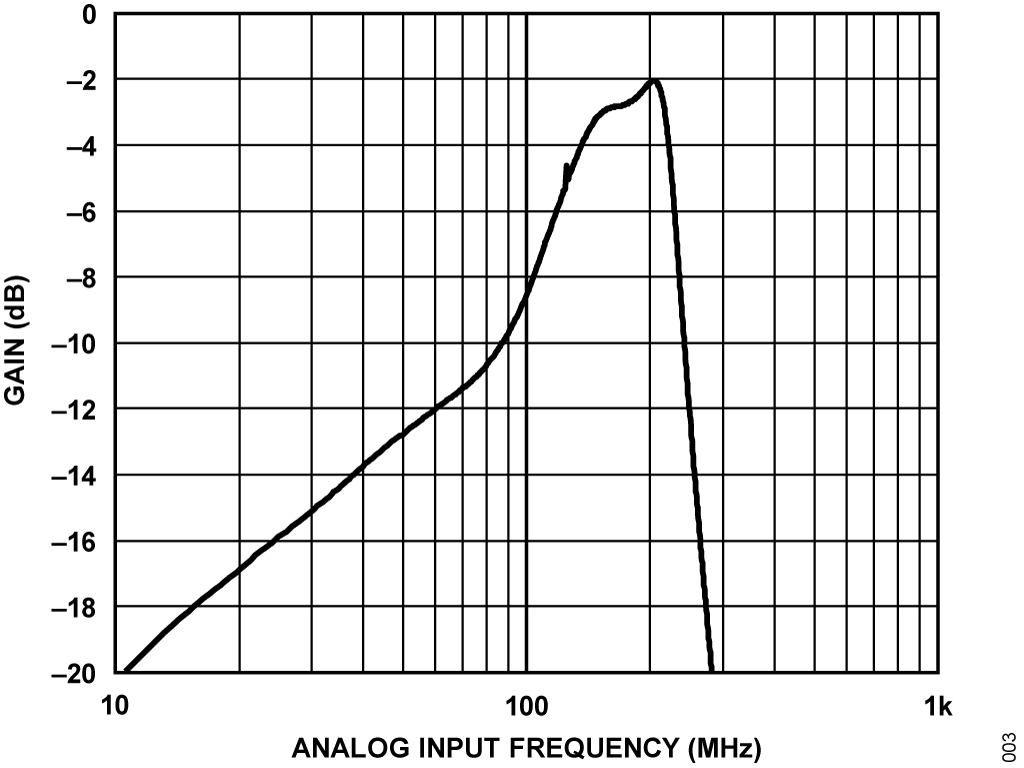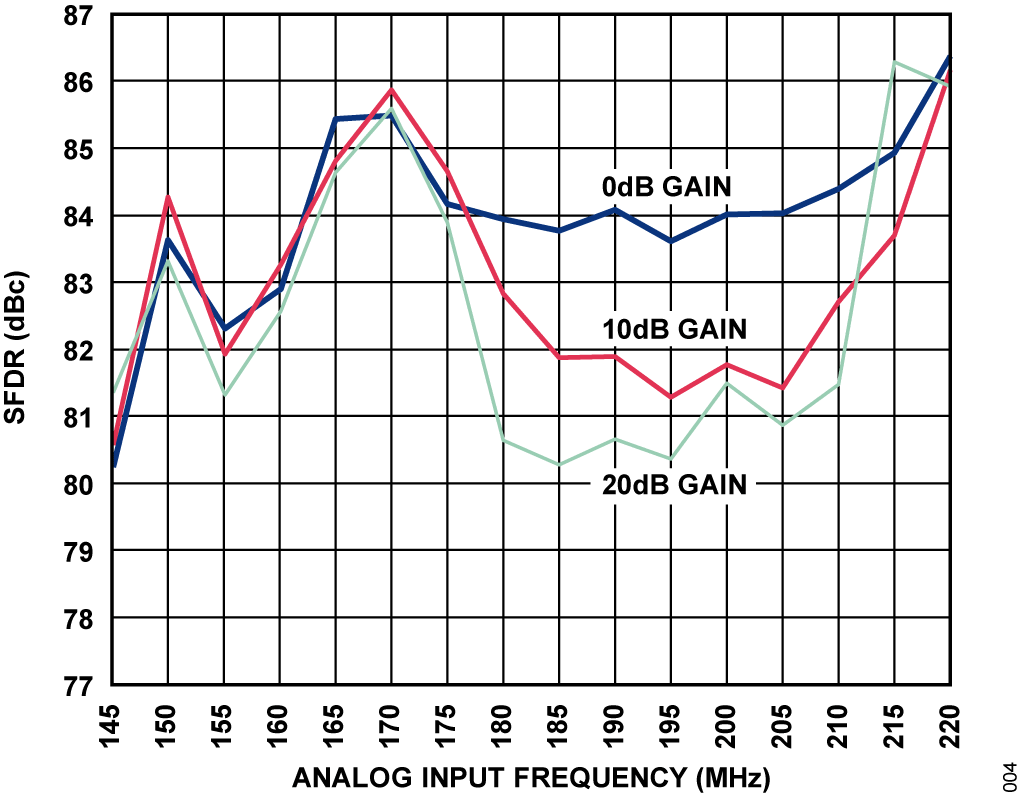AN-2535: バンドパス・アンチエイリアス・フィルタを使用した高性能、高IF、75MHz 帯域幅、14 ビット、250MSPS のレシーバ・フロント・エンド
回路の機能とその利点
図1 に示す回路は、ワイド・ダイナミック・レンジ、高速、デジタル制御の可変ゲイン・アンプ(VGA)であるADL5202 と、14 ビット、250MSPS のデュアルA/D コンバータ(ADC)であるAD9643 をベースとする、75MHz 帯域幅のレシーバ・フロント・エンドです。

図1. クワッドIF レシーバ・フロント・エンドのシングル・チャンネル(簡略図:接続の一部およびデカップリングは非表示)、ゲイン、損失、および信号レベルは10MHz での測定値
5 次バターワース・アンチエイリアス・フィルタは、アンプおよびADC の性能およびインターフェース要件に基づいて最適化されています。フィルタ・ネットワークや他の抵抗成分による全挿入損失は約2.3dB です。バンドパス・フィルタを備えた回路全体には、(145MHz から220MHz までの)75MHz の1dB 帯域幅と、(120MHz から230MHz までの)110MHz の3dB 帯域幅があります。バンドパス平坦性は1dB です。
この回路は、182.5MHz(第2 ナイキスト領域)を中心とする75MHz 帯域幅のIF 信号を、245.76MSPS のサンプリング・レートで処理するように最適化されています。75MHz の帯域幅を182.5MHz アナログ入力で測定したS/N 比(SNR)とスプリアス・フリー・ダイナミック・レンジ(SFDR)は、それぞれ68.4dBFS と80.7dBc です。
回路の説明
図1 に示す回路は、シングルエンド入力を受け入れ、帯域幅の広い(5MHz~300MHz)M/A-COM TC3-1T+ 1:3 (Z)トランスを用いて、その入力を差動入力に変換します。6.0GHz 差動アンプADL5202 には、150Ω の差動入力インピーダンスがあり、0dB、10dB、20dB の3 つのゲイン設定値で動作します。
ADL5202 は、AD9643 に最適なドライバであり、バンドパス・フィルタを介してADC に至るまでの完全差動アーキテクチャにより、良好な高周波数同相モード除去を実現すると共に、2 次歪み成分を最小限に抑えます。ADL5202 のプログラム可能なゲイン範囲は、0.5dBステップで-11.5dB~+20dBです。この回路では、3 つのゲイン設定値を用いて、ADL5202 とAD9643 の高い性能を実証します。
フィルタ・ネットワークの挿入損失は約2.3dB であり、2.3dB より大きい正のゲイン値となるようADL5202 をプログラムすれば、アンプのゲインを用いてこの損失を補償できます。このゲインは、アンプからのノイズの影響を最小限に抑える効果もあります。
アンチエイリアス・フィルタは、標準的なフィルタ設計プログラム(この場合は、Agilent のAdvanced Design System(ADS))で設計された5 次バターワース・バンドパス・フィルタです。バターワース・フィルタを選択したのは、平坦な応答を持つためです。他のフィルタ設計プログラムは、Nuhertz TechnologiesまたはQuite Universal Circuit Simulator(Qucs)Simulation から入手可能です。
最高性能を実現するには、ADL5202 に150Ω の正味差動負荷をかけます。1μH のインダクタは、ADL5202 の出力段にバイアスをかけ、直列キャパシタは、アンプ出力のこのバイアス電圧からフィルタおよびADC を分離します。ADL5202 の出力には、フィルタの入力および出力の終端抵抗による約145Ω のインピーダンスと、ADC 入力でのADC 抵抗および直列ダンピング抵抗とが組み合わさった負荷が加わります。
ADC 入力と直列の20Ω 抵抗は、フィルタおよびアンプから内部スイッチング・トランジェントを分離します。ADCと並列の2 つの162Ω 抵抗は、ADC の入力インピーダンスの低減に役立ち、性能の予測可能性を向上させます。
AD9643 の差動入力インピーダンスは、2.2pF が並列配置され約3kΩ です。実数成分と虚数成分は、このタイプのスイッチド・キャパシタ入力ADC の入力周波数の関数です。この分析については、アプリケーション・ノートAN-742 を参照してください。
5次バターワース・フィルタは、100Ω の信号源インピーダンス、293Ω の負荷インピーダンス、75MHz の1dB 帯域幅、および110MHz の3dB 帯域幅で設計されています。図2 に、フィルタの最終的な回路値を示します。フィルタ受動部品について選定した値は、プログラムが生成した値に最も近い標準値を用いました。ADC の2.2pF の内部容量は、フィルタ設計における最終的なシャント容量の一部として使用されています。ADC 入力におけるこのシャント容量は、ADC 入力サンプリング・ネットワークからのキックバック電荷電流の低減に役立ち、フィルタ性能を最適化します。

図2. ZS = 100Ω、ZL = 293Ω、fC = 182.5MHz の5 次差動バターワース・フィルタの最終設計値
表1 に、システムの実測性能をまとめています。ここで、3dB帯域幅は110MHz です。ネットワークの全挿入損失は約2.3dBです。
| Performance Specifications at 1.75 V p-p FS | Final Result |
| Cutoff Frequency fLOW (−1 dB) | 145 MHz |
| Cutoff Frequency fHIGH (−1 dB) | 220 MHz |
| Cutoff Frequency fLOW (−3 dB) | 120 MHz |
| Cutoff Frequency fHIGH (−3 dB) | 230 MHz |
| Pass-Band Flatness (10 MHz to 190 MHz) | 1 dB |
| SNR FS at 140 MHz | 68.4 dBFS |
| SFDR at 140 MHz | 80.7 dBc |
| 80.7 dBc/84.5 | |
| H2/H3 at 140 MHz |
dBc |
| Overall Gain at 182.5 MHz (ADL5202 Gain = 20 dB) | 21.8 dB |
| Input Drive at 182.5 MHz | −13.0 dBm |
図3 に最終的なフィルタ回路の帯域幅応答、図4 および図5 にS/N 比およびSFDR 性能を示します。

図3. パスバンド平坦性の性能とアナログ入力周波数の関係

図4. SFDR 性能とアナログ入力周波数の関係(0dB ゲイン、10dB ゲイン、および20dB ゲイン)

図5. S/N 比性能とアナログ入力周波数の関係(0dB ゲイン、10dB ゲイン、および20dB ゲイン)
フィルタおよびインターフェースの設計手順
このセクションでは、フィルタのあるアンプ/ADC インターフェースの一般的な設計手法を提示します。アンプおよびADCによる一般的な回路では、最適な性能(帯域幅、S/N 比、およびSFDR)を実現するために、以下のような特定の設計上の制約が課せられます。
- 最適な性能を得るために、データシートで推奨されている適切な直流負荷がアンプに加わるようにする必要があります。
- アンプと電源の間には直流バイアス・インダクタを用いて、アンプ出力を適切にバイアスします。
- ADC の入力インピーダンスは外部の並列抵抗によって低減する必要があり、適切な直列抵抗を用いてADC をフィルタから分離します。この直列抵抗はピーキングも低減します。
この設計手法は、大半の高速ADC の比較的高い入力インピーダンスと、駆動源の比較的低いインピーダンスを利用することによって、フィルタの挿入損失を最小限に抑えるのに役立ちます。
回路最適化手法とトレードオフ
このインターフェース回路のパラメータは相互に強く依存しているため、すべての主要な仕様(帯域幅、帯域幅の平坦性、S/N比、SFDR、およびゲイン)について回路を最適化するのはほぼ不可能です。ただし、帯域幅応答においてしばしば発生するピーキングは、駆動アンプ出力直列抵抗(低インピーダンス出力の場合)やADC 入力と直列の抵抗(図1 の回路の場合、20Ω)を変化させることによって最小限に抑えることができます。
ADC 入力の直列抵抗は、ADC 内の内部サンプリング・キャパシタからの残留電荷注入によって生じる歪みを最小限に抑えるように選択します。この抵抗を増大させることでも、帯域幅のピーキングは低減する傾向があります。
ただし、ADC 入力の直列抵抗を増大させると信号減衰も増加します。そのためADC の入力範囲を満たすよう、アンプはより大きな信号を駆動する必要があります。
パスバンド平坦性を最適化するもう1 つの方法は、フィルタ・シャント・キャパシタを少量だけ変化させることです。
ADC 入力終端抵抗(図1 の回路の場合、364Ω)は通常、正味のADC 入力インピーダンスが200Ω~400Ω になるように選択する必要があります。この範囲内にすることにより、ADC 入力容量の影響は低減し、フィルタ設計を安定化できますが、回路の挿入損失は増大します。この値を大きくすることでも、ピーキングは減少します。
こうしたトレードオフのバランスをとるのは、少し困難なことがあります。この設計では、各パラメータに等しい重み付けとしているため、選択された値は、すべての設計特性についてインターフェース性能を代表するものとなっています。一部の設計では、システム要件に応じて様々な値を選択して、SFDR、S/N 比、または入力駆動レベルを最適化できます。
この設計におけるSFDR 性能は、図1 に示されるように、アンプのインターフェース部品値とADC のインターフェース部品値の2 つの因子により決定されます。表1 および図4 に示す最終的なSFDR 性能値は、フィルタ設計で使用される基板の寄生成分および非理想的成分を考慮に入れてフィルタ設計の最適化を行った後に得られたものです。
この特定の設計で可能になるもう1 つのトレードオフは、ADCフルスケール範囲の設定値です。この設計で得られたデータの場合、フルスケールのADC 差動入力電圧は1.75V p-p に設定しました。これはSFDR を最適化するものです。フルスケール入力範囲を2.0V p-p に変更すると、S/N 比はわずかに向上しますが、SFDR 性能は若干低下します。フルスケール入力範囲を逆方向の1.5V p-p に変更すると、SFDR はわずかに向上しますが、S/N 比性能は若干低下します。
この設計の信号は、0.1μF のキャパシタでAC 結合されて、アンプ、その終端抵抗、ADC 入力の間のコモンモード電圧をブロックします。コモンモード電圧の詳細については、AD9643 のデータシートを参照してください。
受動部品とプリント基板の寄生成分に関する考慮事項
この回路に限らず高速回路の性能は、適切なプリント基板(PCB)のレイアウトに大きく左右されます。この中には、電源バイパス、制御されたインピーダンス・ライン(必要な場合)、部品の配置、信号配線、電源プレーン、グランド・プレーンが含まれますが、これらに限定するものではありません。高速ADC およびアンプ向けのPCB レイアウトの詳細については、チュートリアルMT-031 およびMT-101を参照してください。
フィルタ内の受動部品には、寄生成分の小さい表面実装キャパシタ、インダクタ、および抵抗を使用します。選択したインダクタはCoilcraft 0603CS シリーズのものです。フィルタの表面実装キャパシタは、安定性と精度を考慮して、5%、C0G、0402 タイプを使用します。

